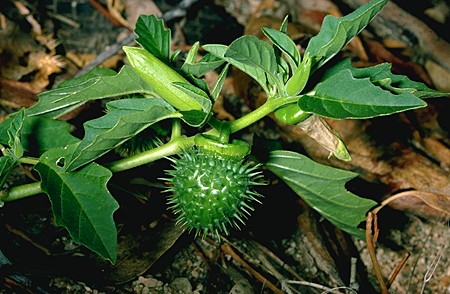
Synonymy
Datura leichhardtii F. Muell. ex Benth., Fl. Austral. 4: 468 (1868)
T: Gulf of Carpentaria, Landsborough s.n.; syn: MEL; Ashburton River, Walcott s.n.; syn: n.v.; Gilbert River, F. Mueller s.n.; syn: K, MEL; Comet River, L.Leichhardt s.n.; syn: MEL; Suttor River, D'Orsay s.n.; lecto: K, iso: K, MEL, fide L. Haegi, Austral. J. Bot. 24: 428 (1976); Rockingham Bay, P.O'Shanesy s.n.; syn: MEL; Armadillo, Barton s.n.; syn: MEL.
Opinions vary as to whether this is a native or introduced species but it is now generally thought that D. leichhardtii was an early introduction to Australia from the New World and that it is likely to be conspecific with D. pruinosa. See D.E.Symon & L.Haegi (1991). Datura (Solanaceae) is a
Description
Stout annual herb, glabrous or sparsely pubescent with non-glandular hairs.
Mature leaves rhomboid to angularly ovate, the lamina up to 8 cm long, more or less regularly serrate to sinuate.
Calyx to 4 cm long, 5–lobed, the base persistent in fruit; lobes 7–10 mm long. Corolla 4–7 cm long, usually cream; limb appearing 10–lobed, alternate lobes shallow-triangular or ending in a slender point 5–7 mm long. Stamens not exserted; anthers 3–4 mm long. Style to 4.5 cm long; stigma level with or below anthers.
Capsule globose or nearly so, 2–3 cm long, deflexed, spiny; spines numerous, conical, sharp, of various lengths, the longest 4–9 mm; persistent base of calyx to 7 mm long. Seeds 4–5 mm long, light brown to grey-brown.
Distribution and ecology
Widespread in semi-arid areas in Qld, N.S.W., S.A., W.A., and N.T.
Frequently associated with water courses and flood plains. Generally considered endemic to Australia but evidence points to it originating in central America (Symon & Haegi 1991).
Notes
Sometimes poisonous to sheep.
Selected specimens
W.A.: Hamersley Range, J.V. Blockley 293 (PERTH). N.T.: Temple Bar Creek, J. Must 1400 (DNA). S.A.: Flinders Range, W.R. Barker 300 (AD). Qld: near Windorah, S.L. Everist 7441 (BRI). N.S.W.: Site B, near Willangee Stn, 1974, J. Pickard s.n. (NSW).
Derivation of epithet
Named in honour of the collector or the type, the explorer Ludwig Leichhardt (1831-?1848).
Images and information on web
Information about this species in NSW can be accessed through the PlantNET site where there is also an image of a herbarium collection.
The Datura and Brugmansia Society has superb images of this species in all its life stages on its site: see www.abads.net/datura/leichhardtii/ There are also further images on this site distinguishing between D. leichhardtii and D. inoxia.
Further information can be found on the Weeds in Australia site.
Further information about the toxic properties of this plant can be found with a search in the FDA Poisonous Plant Database
Plant status (if any)
General information about Datura species as declared plants in
All species of Datura are declared in Western Australia, Tasmania and Northern Territory while D. ferox, D. inoxia and D. stramonium are included in Victorian legislation.
Information on the occurrence and declaration of Datura in
A fact sheet for this species can be downloaded from the SA eFlora site.


